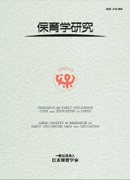Volume 44, Issue 2
Displaying 1-24 of 24 articles from this issue
- |<
- <
- 1
- >
- >|
Foreword
-
2006Volume 44Issue 2 Pages 99-100
Published: December 25, 2006
Released on J-STAGE: August 04, 2017
Download PDF (174K)
Part I Free Topic Articles
Articles
-
2006Volume 44Issue 2 Pages 104-113
Published: December 25, 2006
Released on J-STAGE: August 04, 2017
Download PDF (1402K) -
2006Volume 44Issue 2 Pages 114-123
Published: December 25, 2006
Released on J-STAGE: August 04, 2017
Download PDF (1165K) -
2006Volume 44Issue 2 Pages 124-134
Published: December 25, 2006
Released on J-STAGE: August 04, 2017
Download PDF (1321K) -
2006Volume 44Issue 2 Pages 135-144
Published: December 25, 2006
Released on J-STAGE: August 04, 2017
Download PDF (1118K) -
2006Volume 44Issue 2 Pages 145-155
Published: December 25, 2006
Released on J-STAGE: August 04, 2017
Download PDF (1174K) -
2006Volume 44Issue 2 Pages 156-166
Published: December 25, 2006
Released on J-STAGE: August 04, 2017
Download PDF (1151K) -
2006Volume 44Issue 2 Pages 167-177
Published: December 25, 2006
Released on J-STAGE: August 04, 2017
Download PDF (2991K) -
2006Volume 44Issue 2 Pages 178-188
Published: December 25, 2006
Released on J-STAGE: August 04, 2017
Download PDF (1175K) -
2006Volume 44Issue 2 Pages 189-199
Published: December 25, 2006
Released on J-STAGE: August 04, 2017
Download PDF (1125K) -
2006Volume 44Issue 2 Pages 200-209
Published: December 25, 2006
Released on J-STAGE: August 04, 2017
Download PDF (1047K) -
2006Volume 44Issue 2 Pages 210-221
Published: December 25, 2006
Released on J-STAGE: August 04, 2017
Download PDF (1235K) -
2006Volume 44Issue 2 Pages 222-234
Published: December 25, 2006
Released on J-STAGE: August 04, 2017
Download PDF (1326K)
Practice Research
-
2006Volume 44Issue 2 Pages 235-245
Published: December 25, 2006
Released on J-STAGE: August 04, 2017
Download PDF (1254K)
Research Data
-
2006Volume 44Issue 2 Pages 246-256
Published: December 25, 2006
Released on J-STAGE: August 04, 2017
Download PDF (1243K)
Part II Committee Report
Assignment Committee Report
-
2006Volume 44Issue 2 Pages 258-
Published: December 25, 2006
Released on J-STAGE: August 04, 2017
Download PDF (193K) -
2006Volume 44Issue 2 Pages 259-270
Published: December 25, 2006
Released on J-STAGE: August 04, 2017
Download PDF (1104K)
Report on the 6th Symposium Planned by the International Exchange Committee
-
2006Volume 44Issue 2 Pages 271-280
Published: December 25, 2006
Released on J-STAGE: August 04, 2017
Download PDF (956K)
Report on the Joint Research Meeting of the Assignment Committee and the International Exchange Committee
-
2006Volume 44Issue 2 Pages 281-292
Published: December 25, 2006
Released on J-STAGE: August 04, 2017
Download PDF (1261K)
Part III A Step in Early Childhood Care and Education
-
2006Volume 44Issue 2 Pages 294-303
Published: December 25, 2006
Released on J-STAGE: August 04, 2017
Download PDF (1135K) -
2006Volume 44Issue 2 Pages 304-312
Published: December 25, 2006
Released on J-STAGE: August 04, 2017
Download PDF (1078K)
Contents
-
2006Volume 44Issue 2 Pages 313-314
Published: December 25, 2006
Released on J-STAGE: August 04, 2017
Download PDF (86K)
Afterword
-
2006Volume 44Issue 2 Pages 315-
Published: December 25, 2006
Released on J-STAGE: August 04, 2017
Download PDF (62K)
publication data
-
2006Volume 44Issue 2 Pages App7-
Published: December 25, 2006
Released on J-STAGE: August 04, 2017
Download PDF (35K)
- |<
- <
- 1
- >
- >|
